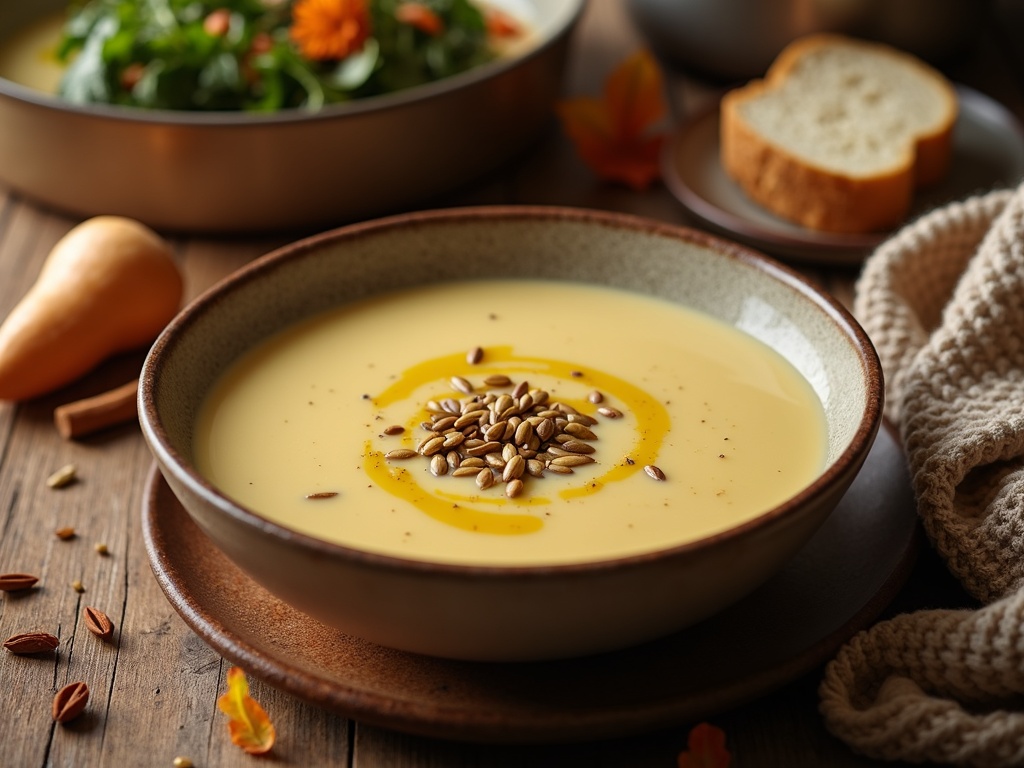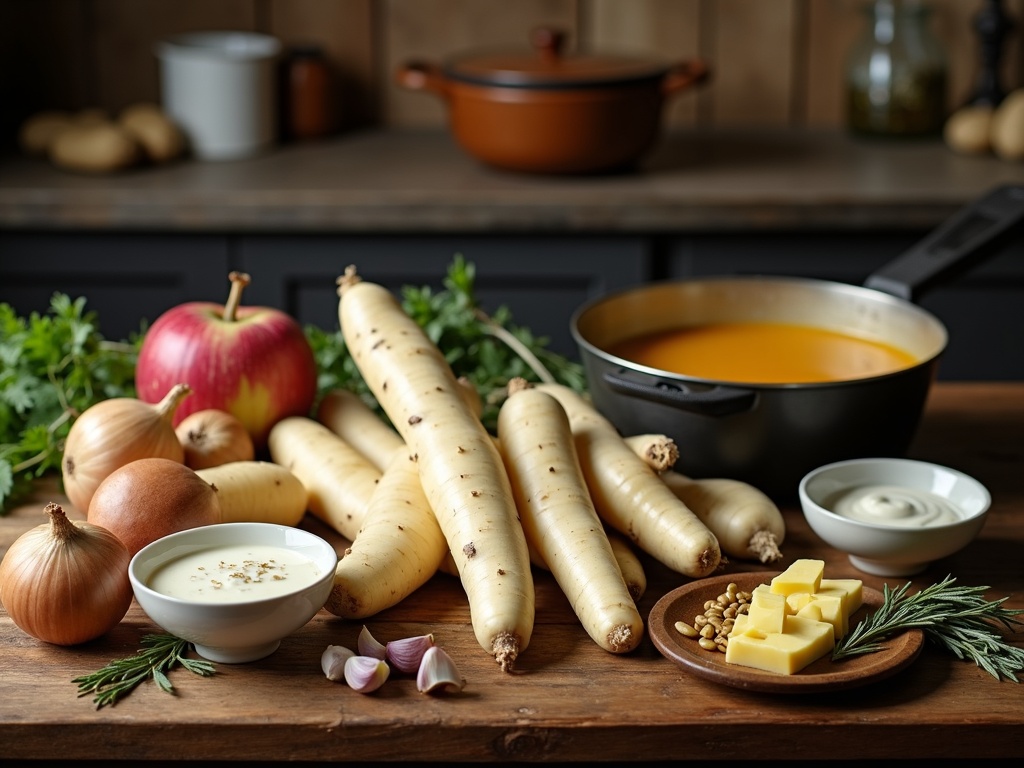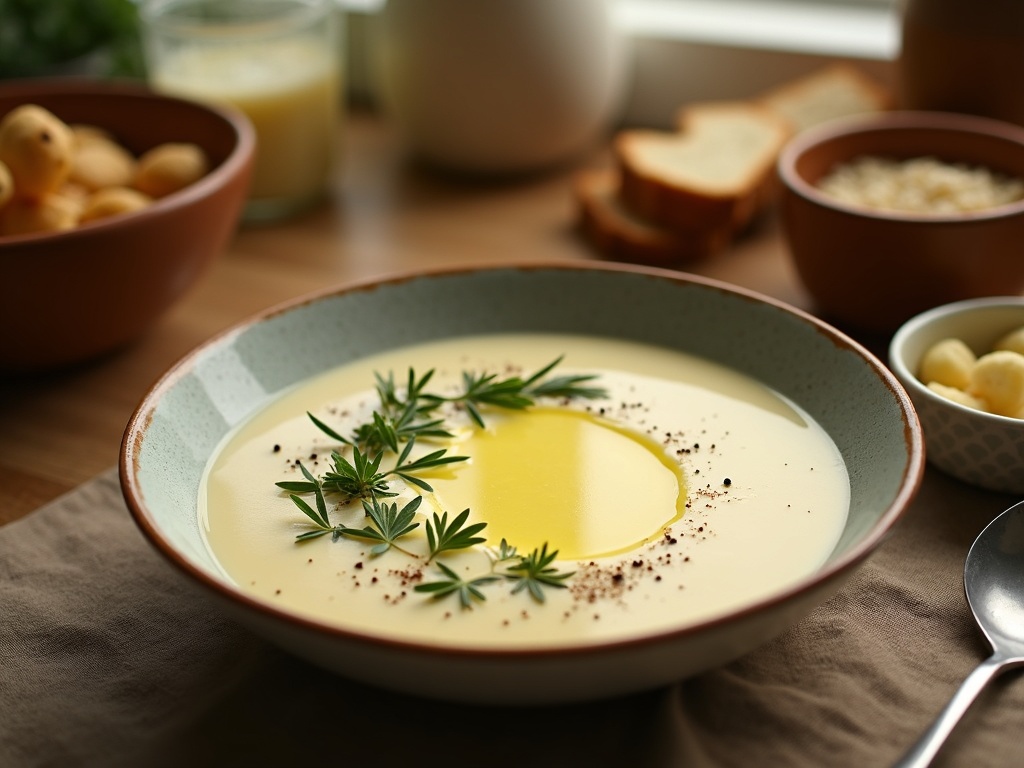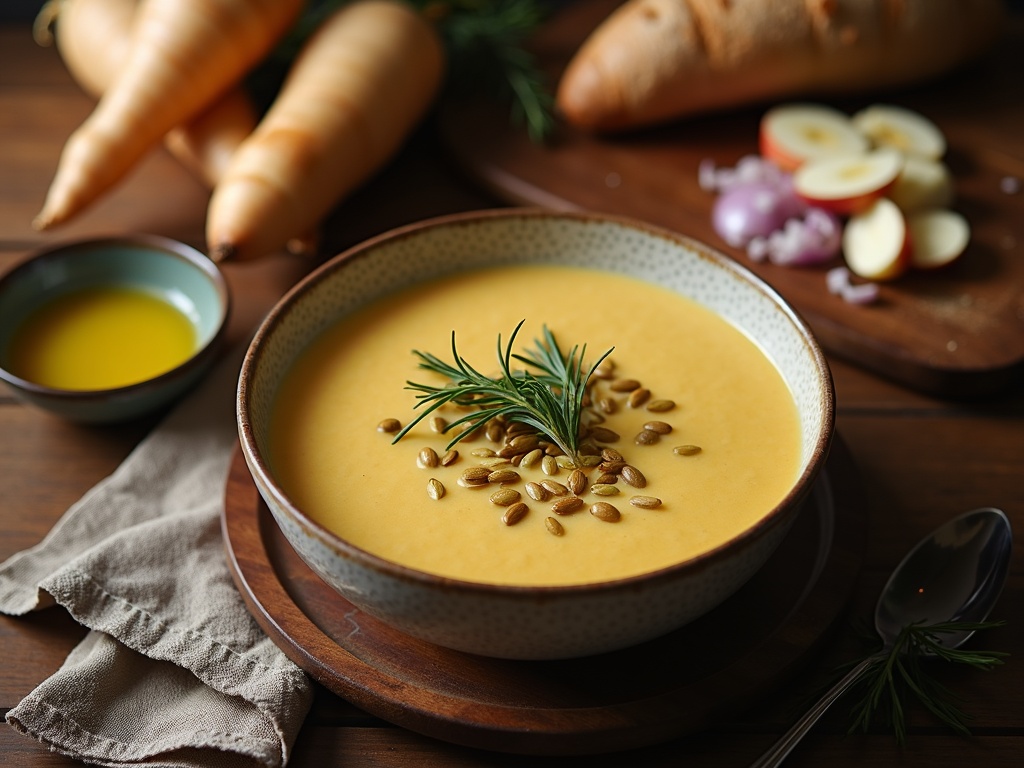Parsnip soup combines comfort and nutrition in a silky, flavorful experience that offers surprising health benefits in every spoonful. This root vegetable creates a velvety dish packed with essential nutrients while staying low in calories and fat, making it a perfect addition to any seasonal menu.
Find In This Article
Key Takeaways
- Parsnip soup contains approximately 100 calories per cup with just 0.3g of fat while providing significant amounts of vitamin C, vitamin K, and folate.
- The natural sweetness of parsnips intensifies when roasted before blending, creating complex flavor notes that elevate this humble vegetable.
- Both preparation methods—direct cooking or roasting first—yield excellent results, with the soup coming together in just 30-45 minutes.
- For texture variety, garnish with toasted seeds, croutons, or herbs to contrast with the smooth consistency of the soup.
- Parsnip soup stores well for 3-5 days refrigerated or up to 3 months frozen, making it perfect for meal preparation.
Why Parsnip Soup is Your Next Comfort Food
When the weather turns chilly, I turn to comforting soups that warm both body and soul. Parsnip soup has become my go-to option—a creamy, flavorful dish that brings together simplicity and nutrition in one steaming bowl. This root vegetable, closely related to carrots, transforms into a silky soup that’s surprisingly light yet satisfying.
Nutritional Powerhouse in a Bowl
Parsnip soup isn’t just delicious—it’s packed with impressive nutritional benefits that make it a smart addition to any meal plan. A single cup serving contains just 100 calories, making it an excellent choice for light lunches or dinner starters. The nutrition profile includes a mere 0.3g of fat, 24g of carbohydrates, and 3g of protein—perfect for balanced eating.
I’ve found parsnips to be surprisingly rich in essential nutrients. Each spoonful delivers dietary fiber that keeps me feeling full longer, along with significant amounts of Vitamin C for immune support, Vitamin K for bone health, and folate which is crucial for cell function. This nutrient density makes carrot and parsnip soups particularly valuable during cold and flu season.
What makes this soup especially beneficial is its low glycemic index. Unlike some comfort foods that cause blood sugar spikes, parsnip soup helps maintain steady blood sugar levels—an important consideration for anyone managing their glucose intake or following a balanced diet.
The creamy texture might fool you into thinking it’s loaded with heavy cream, but the velvety consistency comes primarily from the parsnips themselves. I often prepare mine with just a touch of coconut milk or cashew cream for added richness without compromising its nutritional value. This subtle sweetness pairs wonderfully with warm spices like nutmeg, cinnamon, or ginger.
For extra depth of flavor, I roast the parsnips before blending them into soup. This simple step caramelizes their natural sugars, creating a complex flavor profile that elevates this humble vegetable to star status. The earthiness of parsnips also makes them an excellent partner for hearty spinach soup or as a base for more complex flavor combinations.
I like to garnish my parsnip soup with toasted seeds or nuts for added texture and nutritional boost. A sprinkle of pumpkin seeds adds crunch and zinc, while a swirl of olive oil brings heart-healthy fats and a beautiful finish to the presentation.
For busy weeknights, I’ve found that parsnip soup freezes beautifully, making it perfect for meal prep. A batch divided into portions provides quick, nourishing meals when time is tight. This practical aspect, combined with the affordable cost of parsnips, makes this soup as budget-friendly as it is nutritious.
The versatility of parsnip soup extends to its pairing potential. It complements homemade chicken pie for a complete meal, or stands alongside a crisp salad for lighter fare. During colder months, I often prepare a rotation of root vegetable soups, alternating parsnip soup with celery soup or classic zuppa soup for variety.
Even if you’re new to cooking with parsnips, this soup offers a foolproof introduction to this underappreciated vegetable. Its mild flavor and creamy texture have won over even the most vegetable-resistant dinner guests at my table.

Essential Ingredients for the Perfect Bowl
The foundation of any outstanding parsnip soup begins with a careful selection of quality ingredients. I’ve found that using fresh, seasonal parsnips makes a noticeable difference in the final flavor profile. These root vegetables offer a naturally sweet, nutty taste that forms the backbone of this comforting dish.
Building Your Flavor Base
Every great homemade soup recipe starts with aromatics, and parsnip soup is no exception. Onions create that essential savory foundation, while garlic adds depth and complexity. I typically use one large onion and 2-3 garlic cloves for a standard batch serving 4-6 people. The choice of stock significantly impacts the final taste – vegetable stock keeps things light and vegetarian-friendly, while chicken stock adds richness and body to the hearty vegetable soup.
For creaminess, you have options depending on your dietary preferences. A splash of cream transforms the soup into a luxurious treat, while milk offers a lighter alternative. For dairy-free versions, coconut milk or cashew cream works beautifully.
The supporting cast of ingredients can vary based on your taste preferences:
- Potatoes: Add a handful of diced potatoes for extra body and a velvety texture
- Apples: A single chopped apple introduces a pleasant tartness that balances the parsnips’ sweetness
- Fresh herbs: Thyme or rosemary sprigs infuse the soup with aromatic notes
- Butter: A tablespoon for sautéing adds richness to the root vegetable soup
- Leeks: Can replace or complement onions for a milder, more complex flavor
I always keep my seasoning simple – salt and freshly ground black pepper let the natural flavors shine. However, a pinch of nutmeg or a dash of white pepper can elevate the soup further.
For those who enjoy customization, consider these additions just before serving:
- Toasted pumpkin seeds for crunch
- A swirl of olive oil
- Crispy fried sage leaves
- Croutons for texture contrast
- A dollop of thick creamy soup enhancer like crème fraîche
The beauty of parsnip soup lies in its versatility. I often make a basic version then divide it, creating variations with different garnishes. This approach is particularly helpful when serving guests with varying tastes or when preparing multiple soup options for the week ahead.
When shopping for parsnips, look for firm, small to medium-sized roots – they tend to have sweeter flesh and fewer woody cores than larger specimens. This simple ingredient selection will set you up for kitchen success with minimal effort.

Health-Boosting Properties You Need to Know
Parsnip soup doesn’t just warm you up on cold days—it’s packed with impressive nutritional benefits that can transform your health routine. I’ve discovered that this humble root vegetable delivers powerful health advantages that many people overlook.
Digestive Health and Nutrient Powerhouse
Each cup of parsnip soup contains approximately 6g of dietary fiber, making it an excellent choice for improving digestive health. This fiber content helps regulate bowel movements and prevents constipation while feeding the beneficial bacteria in your gut. I’ve found that regular consumption can significantly improve overall gut health, which serves as the foundation for your immune system.
The impressive nutritional profile doesn’t stop there. Parsnips are rich in folate, a B vitamin essential for DNA repair and creation of new cells. This makes parsnip soup particularly valuable during periods of growth and healing. The antioxidants present in parsnips help combat free radicals in your body, potentially reducing inflammation and lowering the risk of chronic diseases.
For those concerned with skin health, the vitamin C content in parsnip soup provides natural support for collagen production. I’ve noticed improved skin elasticity and faster healing when incorporating this nutrient-dense soup into my meal rotation. This same vitamin C boost strengthens your immune defenses, helping your body fight off seasonal illnesses more effectively.
Blood Sugar Management and Immune Support
Parsnips have a unique combination of fiber and complex carbohydrates that makes them suitable for blood sugar management. Unlike simple carbs that cause rapid spikes in glucose levels, the nutrients in homemade vegetable soups like parsnip provide sustained energy without dramatic fluctuations in blood sugar.
The natural immune-boosting properties of parsnip soup come from its impressive vitamin and mineral content. Beyond vitamin C, parsnips contain:
- Potassium for heart and muscle function
- Vitamin K for proper blood clotting
- Manganese which supports metabolism
- Phosphorus for bone health and energy production
I’ve found that incorporating nutrient-rich soups into my weekly meal plan provides tangible health benefits. When you combine parsnips with other vegetables like celery or carrots, you create a powerful nutritional blend that supports multiple body systems simultaneously.
For maximum health benefits, I recommend preparing your soup from scratch rather than using canned varieties. This allows you to control sodium levels while preserving the nutritional integrity of the ingredients. Adding immune-supporting herbs like thyme, rosemary, or turmeric can enhance both flavor and health properties.
The soluble fiber in parsnips also supports heart health by helping to lower cholesterol levels. When combined with heart-healthy fats like olive oil in your homemade soup recipes, you’re creating a meal that nourishes multiple aspects of your cardiovascular system.
For those interested in weight management, parsnip soup offers satisfying fullness with relatively few calories, making it an excellent choice for maintaining healthy weight while still enjoying flavorful meals. The fiber content helps control appetite, while the complex carbs provide lasting energy throughout your day.
Try pairing your parsnip soup with a protein-rich side dish for a complete meal that balances your macronutrient intake while delivering maximum nutritional benefit.
Master Chef’s Guide to Preparation
Preparing parsnip soup isn’t complicated, but a few chef-proven techniques can transform it from ordinary to extraordinary. I’ve refined these methods over years of testing, and they consistently deliver exceptional results in just 30-45 minutes.
Essential Preparation Techniques
The foundation of any good parsnip soup starts with properly sautéing aromatics. I heat olive oil in a heavy-bottomed pot, then add finely diced onions and cook until translucent – about 5 minutes. Next comes minced garlic, which I cook for just 30 seconds until fragrant but not browned. This aromatic base builds the flavor profile that supports the star ingredient.
For the classic method, I add chopped parsnips directly to the pot, stirring to coat them in the aromatic oil before adding vegetable stock. This approach works perfectly when time is limited.
However, for a more complex flavor profile, I often use the gourmet variation: roasting parsnips first. I toss peeled and chopped parsnips with olive oil, salt and pepper, then roast at 425°F for 20-25 minutes until caramelized. This extra step develops deeper, sweeter notes that make the soup truly special – similar to how roasting enhances carrot soup flavors.
The thickness of your soup affects both texture and satisfaction. I’ve found several effective thickening options:
- Cornstarch slurry: Mix 1 tablespoon cornstarch with cold water before stirring into simmering soup
- Pureed white beans: Adds protein while creating silky texture
- Red lentils: Cook directly in the soup, naturally thickening as they break down
For perfect smoothness, blending technique matters significantly. I prefer using an immersion blender directly in the pot for convenience, but a traditional blender creates the silkiest texture. When using a standard blender, I work in batches and start on low speed before gradually increasing – similar to techniques used for creating velvety spinach soup.
For added dimension, I often finish with a swirl of cream or a sprinkle of toasted seeds. These finishing touches elevate the presentation while adding textural contrast to the smooth, velvety base that makes parsnip soup so comforting.
Serving and Storage Secrets
I’ve discovered that parsnip soup truly shines when paired with the right accompaniments and stored correctly. The naturally sweet and earthy flavor of parsnip soup makes it versatile for different serving styles and temperature preferences.
Perfect Pairings and Presentation
Nothing complements a bowl of hearty vegetable soup like freshly baked crusty bread for dipping. The contrast between the smooth soup and crunchy bread creates a satisfying textural experience. Homemade croutons also add a wonderful crunch – simply cube day-old bread, toss with olive oil and herbs, then bake until golden.
For an elegant finishing touch, a light drizzle of good-quality olive oil creates a beautiful presentation while adding richness to each spoonful. This simple addition transforms even the most basic homemade soup recipe into something restaurant-worthy.
When it comes to garnishing, fresh herbs make all the difference:
- Finely chopped parsley adds a fresh, peppery note that balances the sweetness of parsnips.
- Snipped chives provide a mild onion flavor and attractive green flecks.
- A sprinkle of cracked black pepper offers subtle heat and visual contrast.
One of the things I love about parsnip soup is its temperature versatility. While most people enjoy it piping hot during colder months, it’s surprisingly delicious when chilled in summer, similar to a traditional zuppa with a twist. The cooling effect brings out different flavor notes in the parsnips.
For storage, parsnip soup keeps beautifully in the refrigerator for 3-5 days, making it perfect for meal prep. I’ve found that storing it in airtight containers is non-negotiable – this prevents the soup from absorbing other flavors in your fridge and maintains its freshness.
If you want to extend shelf life further, parsnip soup freezes exceptionally well for up to 3 months. I recommend portioning it into individual servings before freezing for easy weeknight meal options similar to how you might prepare other favorites.
When reheating, gentle heat is key to preserving the soup’s texture and flavor. I typically reheat on the stovetop over medium-low heat, stirring occasionally. If the soup has thickened during storage, I add a splash of stock, water, or cream to reach the desired consistency. This technique works equally well for creamy vegetable soups of all varieties.
For an extra touch of luxury when serving reheated soup, I sometimes add a fresh garnish or a new topping like toasted nuts or seeds. This refreshes the presentation and adds new flavor dimensions to your comfort food collection, making leftovers feel special rather than repetitive.

Sources:
Journal of Food Science, Healthline, Culinary Institute of America

